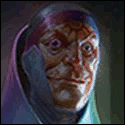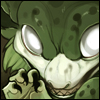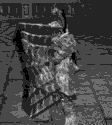|
Fl0yd posted:I will hunt them down for you, but I doubt you'll can actually learn anything from them that I couldn't tell you verbally (and remember, we're talking about WorldCraft here, not your new-fangled Source engine with its massive draw distances and countless polys being thrown about every frame). I shed a tiny tear for Worldcraft. In fact when WoW came out i kept on calling it World of Worldcraft The Source SDK thread is more than adequate and getting you up to speed with source stuff. making banisters arn't a problem any more because 1) there are probably models of it or 2) you can make func_details now which is basically just a way of turning brushes into non hull geometry. VIS compile times rejoice!
|
|
|
|

|
| # ? Jun 3, 2024 23:01 |
|
The Cheshire Cat posted:Clearly, the crate was brought into the room in pieces and assembled in the room! After all, making transportation more difficult is the intended purpose of a crate, right? Or the oversized crate just clips through the walls as you carry it out the doorway, because gently caress you and your "games have to be realistic"-ness!
|
|
|
|
Would using Blender be an okay way to start learning 3D modeling on my own? All of the big name tools used in the industry like Maya and 3DSMax cost tons of money but I don't wanna use something that will end up being a waste of time.
|
|
|
|
|
warburg posted:Would using Blender be an okay way to start learning 3D modeling on my own? All of the big name tools used in the industry like Maya and 3DSMax cost tons of money but I don't wanna use something that will end up being a waste of time. It's good in that you'll learn to use a free, reasonably powerful tool, one that'll enable you to make your own demo reel and hopefully improve your proficiency as a modeling artist. I may be misunderstanding your post here - it looks like you're checking about a level of interest, that this isn't something you're firmly committed about right now. If that's the case, and if you do decide to commit to modeling, you'll likely need to learn Maya/3DSMax in time since a lot of studios strongly recommend (if not require) proficiency with one or both. Don't get me wrong, a poo poo hot artist who's intelligent enough to learn a new tool quickly is often preferred over an okay artist with a strong grasp in specific tools, but there will be applicants with great art and experience with the tools, at least at the AAA level.
|
|
|
|
As a designer that needs placeholder art but is an art nincompoop, is there any better choice than Google SketchUp? Or is this the gold standard these days? EDIT: VV Blender is complete rear end to use. Max/Maya/etc are much better, but are still "actual artists only" sorts of tools with a ton of complexity. SketchUp is a tool that lets even neophytes create relatively stable, useful placeholders. Hence, looking for more tools in that vein. Shalinor fucked around with this message at 19:06 on Jul 2, 2011 |
|
|
|
Shalinor posted:As a designer that needs placeholder art but is an art nincompoop, is there any better choice than Google SketchUp? Or is this the gold standard these days? Blender? I also think you can get student versions of Maya/3ds max from Autodesk's website
|
|
|
|
I've been meaning to start learning LUA for a long time, does anyone have a suggestion as to how to do it? The nice thing about ActionScript 3 is that there's two books to rule them all, which makes it super easy to get started with, but LUA doesn't seem to have that nice perk.
|
|
|
|
Mango Polo posted:I've been meaning to start learning LUA for a long time, does anyone have a suggestion as to how to do it? The nice thing about ActionScript 3 is that there's two books to rule them all, which makes it super easy to get started with, but LUA doesn't seem to have that nice perk. Which books are these? I'd like to learn AS3 and need a good reference and lesson plan.
|
|
|
|
Monochrome posted:Which books are these? I'd like to learn AS3 and need a good reference and lesson plan. Learning ActionScript 3.0 (Rich Shupe and Zevan Rosser) Essential ActionScript 3.0 (Colin Moock) The first is as really wonderful starting point (as long as you have some really basic knowledge of the Flash UI) as it's lesson-oriented, the second is pretty much your reference bible as it's much more in-depth than the first but less newbie-friendly. Start with the first, then when you're done with it and feel like continuing get the second. There's also a really awesome Flash game code website, but I can't remember the name. I'm pretty sure that Shalinor should be able to get you the link though. Shalinor posted:As a designer that needs placeholder art but is an art nincompoop, is there any better choice than Google SketchUp? Or is this the gold standard these days? SketchUp is what I use when I want to show a 3D level idea or make some temporary assets. Works well enough for that purpose as far as I can see. I don't think there's anything that better combines features and straight up ease of use. Mango Polo fucked around with this message at 22:29 on Jul 2, 2011 |
|
|
|
Welp, I just sent my art test back to the company, wish me luck!
|
|
|
|
Silo is extremely easy to learn if you want something a bit more involved than Sketchup.
|
|
|
|
Monochrome posted:Which books are these? I'd like to learn AS3 and need a good reference and lesson plan. You know you have one of the best AS3 hackers IN THE WORLD sitting like 10 feet from your desk, right?
|
|
|
|
Wanted to take a look at learning MEL for Maya or MAXscript. Do I have options besides doing so in 30 days on a trial or stealing them? Has MAXscript changed substantially since Gmax, which I think I have somewhere? Maybe it's enough to rely on my existing programming and scripting background but I should probably take a look. Suppose C# scripting in XSI might do. Pretty crazy all three of these distinct products are Autodesk though.
|
|
|
|
BizarroAzrael posted:Pretty crazy all three of these distinct products are Autodesk though.
|
|
|
|
Well, I started working my way through a book on C# through XNA framework, and on the second little starter project Visual Studio decides it's just not going to open dialogue boxes for anything. God dammit.
|
|
|
|
Shalinor posted:As a designer that needs placeholder art but is an art nincompoop, is there any better choice than Google SketchUp? Or is this the gold standard these days? For more UI stuff, Balsamiq is pretty awesome. Although once you get good with it, you can use it + Paint to mock up some surprisingly decent placeholder art. The senior designer at my company does her placeholder art in Visio. It's bizarrely impressive.
|
|
|
|
I do have a small confession to make. My dream over anything else has been doing Design. Hell theres some writing on my old Laptop that is utter crap, even though it is my favourite thing to do. It does help the degree I am studying revolves around Human Behaviours and poo poo like Economies. (I haven't specialised or chosen to do Geography or Anthropology major yet) Having my week off out in the sticks with no computers/tv/modern technology just let me think about what I want to do. While I am finding the very amateurish 3D models I am making quite fun its not what I see myself doing. Is it worth picking up a design skill like Level Design and writing my rear end off to try and live that dream or is it worth taking a longer route and learning 3D modelling then working my way across after I get established in the industry? Theres quite a few ways I can go around this and I'm not sure. Hell I don't even know what the hell kind of requirements a Designer position would require. Some companies have entirely different definitions from what I've seen. I suppose I could, while writing bigger design documents, begin making small flash game documents and ask friends to help make them (Or learn myself). tl:dr = Protips on game design entry path over the next 2-3 years I'm at University studying my Anthropology/Geography degree? Solus fucked around with this message at 12:43 on Jul 3, 2011 |
|
|
|
Is English your first language?
|
|
|
|
Fl0yd posted:Is English your first language? Yes, I just typically post at midnight and half asleep so Grammar and spelling fails seep through
|
|
|
|
Try level design. The whole 3d modelling thing is very much about producing high quality assets and there's no real aspect of game design in there. If you want to have impact on how the game plays and you have some experience with 3d modelling the basic concepts of it and texturing and such, then try focusing on mapping. Pick a map editor and create awesome levels, thinking about and documenting the design process along the way. UDK, Source SDK, CryEditor, all these are good. Alternatively for pure design, I've always heard that simply going balls out and making what you design is the best way forward.
|
|
|
|
Some self-pimping for a Sunday. gently caress it, why not? http://www.next-gen.biz/features/going-mobile
|
|
|
|
Solus posted:tl:dr = Protips on game design entry path over the next 2-3 years I'm at University studying my Anthropology/Geography degree?
|
|
|
|
Aliginge posted:Try level design. The whole 3d modelling thing is very much about producing high quality assets and there's no real aspect of game design in there. I've been dabbling in level design lately, and one thing that's really helpful is the fact that it doesn't require nearly the level of artistic ability that modelling or concept art does. You probably shouldn't do it if you have absolutely no artistic inclinations at ALL, since you'll still need a good eye for aesthetics, but you don't need to be able to draw or know how to make even the most basic 3D model, thanks to all the pre-existing assets that exist in the engines Aliginge mentioned. Hell, if you ever play TF2, you can see how most maps are built using the same core set of assets, so it's easily possible to make a fully playable TF2 map without having to create a single original model or texture. With something like UDK, if you've got some programming ability you can take the extra step and design a whole new game. If your intention is just to show off your design chops for a portfolio, then there's nothing wrong with using base UDK assets for the game (there are lots of freely available models and textures out there if you want to branch out a bit, too).
|
|
|
|
FreakyZoid posted:You know there's a section in the first post with the heading "Q: I want to be a designer, how do I become a designer"? You should read that, because it applies to you. I did read that, was wondering if there was other things that I might need to do/would look good in a portfolio/resume
|
|
|
|
Lurking Haro posted:Thank you for your time. Sorry for the late reply on this, and I don't know how valuable my advice will be since I only just started as a junior programmer a couple months ago (and have done nothing but putz around with shaders in that time), but one thing that really stood out to me when I saw some of my co-worker's design docs is how much energy is spent on presentation. While a straightforward, informational document might work in the west, in Japan there seems to be more focus on capturing 'feel' with layout, borrowed graphics, and what not. Most 企画書s I've seen end up looking like a cross between a powerpoint presentation and a Famitsu splash page. The flip side of all this is you can get away with using a LOT of obviously cribbed art here; no one really expects a designer to have included much original art in a design spec. Just... don't use Naruto. Other than that my personal opinion (which again should be deprecated in favor of everyone else's in the thread because I basically only know shaders and how to make a certain as-yet-unreleased handheld throw up in intriguing new ways) is it reads more like a loose collection of ideas than a solid design spec. For example you introduce the monsters, but you don't tell us anything about why they're there, what they do, how they move, how the player should interact with them, why they present a challenge, etc. etc. You also go into more detail with the control inputs than you do with the behaviors these controls tie into. For example, walljump: how sensitive should it be to contact with the wall? Should it trigger a few pixels out or only with actual contact? If the character is pressing towards the wall is the jump out a fixed velocity, or does the player have to quickly press the other direction to get any horizontal distance? How sensitive should this be if so? Basically, how do the actual algorithms of motion work -- and how do they tie into the larger gameplay? There's also a lot of them...if your boss told you 'we have to cut half of these' which ones would you keep? How would you justify keeping them? Obviously not all of this is going to make it into a design document but it's stuff you want to consider as you're putting it together. Anyway I hope you have luck finding something in the Kansai area! There's a lot of little studios and whatnot around if you look - http://raku-job.jp/ and such.
|
|
|
Robotic Accolade posted:Sorry for the late reply on this, and I don't know how valuable my advice will be since I only just started as a junior programmer a couple months ago (and have done nothing but putz around with shaders in that time), but one thing that really stood out to me when I saw some of my co-worker's design docs is how much energy is spent on presentation. While a straightforward, informational document might work in the west, in Japan there seems to be more focus on capturing 'feel' with layout, borrowed graphics, and what not. Most 企画書s I've seen end up looking like a cross between a powerpoint presentation and a Famitsu splash page. The flip side of all this is you can get away with using a LOT of obviously cribbed art here; no one really expects a designer to have included much original art in a design spec. Just... don't use Naruto. There is never a too late reply. I'm also busy with the GameDev Challenge, so I won't be working on a new GDD until August. I'm having trouble writing down specific technical details like speed and acceleration if I can't test it. Wouldn't this also be part of the full spec GDD necessary for the programmers? I skimmed through raku-job last fall, but was only looking for part-time jobs in the Tokyo area. So until now what I've heard from responses is that my GDD is too superficial and too focused on ideas instead of how the gameplay exactly works.
|
|
|
|
|
Lurking Haro posted:There is never a too late reply. I'm also busy with the GameDev Challenge, so I won't be working on a new GDD until August. You should definitely look in the Kansai area! There's a ton of companies big and small around here and the quality of living is much better. I live LITERALLY around the block from my company and as a result can set my alarm for 8:30. For me in general your GDD, besides the unpolished-ness, is more of a 'game pitch' rather than a 'game implementation plan'. As a pitch it really needs more polish, and even if it had it it's not the best thing to have in a portfolio- you're not trying to sell the game, you're trying to sell YOU. I think doing the GameDev Challenge is a great idea for you because as has been mentioned many times in this thread before, a planner needs at least passing knowledge of programming and comfort with some sort of scripting or game-making software, as that will be a large part of your actual job. Learning something like Unity will also make your design specs better because you'll actually be able to put something together and see how it works... and when it does work well you'll also have something to add to your portfolio.
|
|
|
|
Solus posted:I do have a small confession to make. My dream over anything else has been doing Design. Hell theres some writing on my old Laptop that is utter crap, even though it is my favourite thing to do. It does help the degree I am studying revolves around Human Behaviours and poo poo like Economies. (I haven't specialised or chosen to do Geography or Anthropology major yet) Want to be a good designer? Study everything. Luckily, you're at a place (a university) where they let you do just that! Take creative writing courses and learn about creating story arcs and defining interesting characters. Take introductory programming courses so you can mock up your own designs and so you know how scripting logic works. Take some 3D introductory courses so you can have someone else train you on Max or Maya. Take history classes to learn how people used to live, and how groups of people organize themselves. Take statistics to learn how to analyze data. Find some way to get them to teach you advanced Excel. Take an improv class to learn how to create dialogue on the fly. If you decide to go with anthropology, try to take cartography classes anyway because they're super valuable. Basically, just about anything you're taught in school will give you more tools as a designer. You then need to take those tools and build what you like so you can start learning what works and what doesn't. Build FPS levels or RPG modules and put them out there for feedback from those game communities. Be truly old-school and go work on a MUD. Create original characters and write short stories, and get feedback from workshops. At every step you need to be getting and giving feedback and iterating. Learn to be brutal with your own work and be honest (but not mean) with others. Take your best stuff and put it in your portfolio. Becoming a designer is a lot like becoming an artist. You can go to college and get a degree, but you have to develop your talent on your own. The courses will give you a foundation, but the portfolio is how you improve.
|
|
|
|
devilmouse posted:You know you have one of the best AS3 hackers IN THE WORLD sitting like 10 feet from your desk, right? I didn't! (Well, I knew he was top-tier.) Still, the last thing I coded was a school assignment in assembly; I'm super rusty. Once I get back up to speed I can manage to not waste time with dumb questions.
|
|
|
|
cgeq posted:Our core team is very small, around half a dozen of us, give and take, over the course of the project, but most of the art is outsourced. Totally missed your reply, but this reminded me of something I wanted to ask other HO devs about. How much work does your studio put into retouching the art that you outsource? Over here it's pretty weird, since the art that we receive back gets criticized, retouched and redrawn so much that I really wonder what the point of outsourcing it in the first place is. I imagine that it should be possible to outsource the art (mostly thinking of NAV backgrounds) without having to spend such an inordinate amount of time cleaning it up, but maybe I'm expecting too much; and our in-house artists can do some pretty amazing work when given a chance (mostly CE content and pre-BFG partnership). Can you shed any light on that? Shalinor posted:Though I am especially confused why a company would ask for a design document as part of their application process. Really? Not a portfolio of implemented game designs? Gameloft is absolutely GL Montreal: Asked for full animation and camera behaviours from a list of games, some 3D level design with full documentation, and then still ten more pages of game design questions. GL Madrid: They wanted a semi-GDD for an iPhone platformer, including complete game mechanic behaviours and a level design that showcases them all. And then an extra 10 pages of unrelated game design questions. GL Barcelona: Same as above + either a playable prototype or a 30 second video mockup of game mechanics with the note that "making it one minute long would be a considerable plus". I dragged myself through the first two, but laughed at Barcelona's test and deleted their email.
|
|
|
|
devilmouse posted:You know you have one of the best AS3 hackers IN THE WORLD sitting like 10 feet from your desk, right?
|
|
|
|
Mango Polo posted:Gameloft is absolutely
|
|
|
Oh my god, I don't know how I overlooked those.FreakyZoid posted:I got bored somewhere around "it's a 2d metroidvania fighting game with ninjas". Nothing about your design excites me as a designer. You gloss over the potentially interesting bit of the non-linear world, and spend pages listing controls and weapons and nine different types of health pickup. Shalinor posted:My feedback was basically going to be exactly what FreakyZoid posted - but in short, you haven't grounded your design at all. This reads like an idea sheet. I see no discussions of mechanics, or what the gameplay actually is, just ideas - and while all design documents go through this phase, this is the phase at which they're the most useless, and certainly not something worth submitting anywhere. All the Japanese terms are because it's for Japanese companies. The reason why it looks like Naruto stuff is because Naruto itself is grounded in all the cliche mystical Ninja stuff. All that stuff was already done in anime and movies from 50 years ago. They ask for GDDs as part of the portfolio, along with a list of previous games. Nothing like the Gameloft requirements. Is there a way to see some complete GDDs? The only ones I saw before is one for Grim Fandango that reads like a walkthrough and a pitch for Metal Gear Solid 2. Lurking Haro fucked around with this message at 13:48 on Jul 4, 2011 |
|
|
|
|
FreakyZoid posted:Since you'll just be cloning someone else's game I wonder why they ask design questions at all. I can see why the ability to recreate animation and camera movement rules would be useful for them, though. They are opening a new studio close by me over in New Orleans. I thought about applying but they didnt have any QA openings.
|
|
|
|
FreakyZoid posted:Since you'll just be cloning someone else's game I wonder why they ask design questions at all. Dayum Son, thats an  ~~Actualy Content. The requirements for the game design stuff for Gameloft New Zealand seem odd for some reason. This is from when they were starting up last year and I couldn' fulfil some of those requirements at the time. I'm kinda suprised the essentials are quite open ended. All they wanted was a vaguely defined portfolio. quote:Skills What confuses me is that every position ever requires previous industry experience to some degree. I understand the field will stagnate and die if you dont take fresh blood in but every position ever seems to require this.
|
|
|
|
Solus posted:What confuses me is that every position ever requires previous industry experience to some degree. I understand the field will stagnate and die if you dont take fresh blood in but every position ever seems to require this. But the job listing you just posted doesn't require industry experience, just experience making games either professionally, personally, or as a part of a mod. 
|
|
|
|
I do BizDev for Ubisoft North America, evaluating submissions for possible 3rd Party Development, Publishing or Distribution deals. Anyone with questions let me know, or any 3rd Party teams for any platform that want to submit, I'd be interested in discussing.
|
|
|
|
devilmouse posted:But the job listing you just posted doesn't require industry experience, just experience making games either professionally, personally, or as a part of a mod. Probably should have put most. I'm gonna stop posting for a week again. 
|
|
|
|
Solus posted:What confuses me is that every position ever requires previous industry experience to some degree. I understand the field will stagnate and die if you dont take fresh blood in but every position ever seems to require this. To that end: Lurking Haro, I can't help but wonder if you wouldn't be having a less odd time of it if you actually had said portfolio.
|
|
|
|

|
| # ? Jun 3, 2024 23:01 |
|
Shalinor posted:This is why we keep saying "portfolio." That's your previous experience in cases like this. You have to make games on your own to get into making games professionally. There are no excuses to get around this - if you can't operate something like Stencyl or Unity? I'm sorry, but almost every single tool you'll be expected to use in the industry is more complicated and less user-friendly than that. You could be like me and be the rear end in a top hat who writes the terribly user-unfriendly internal tools because Hey I'm a programmer not a designer what do you want from me it works doesn't it? 
|
|
|































